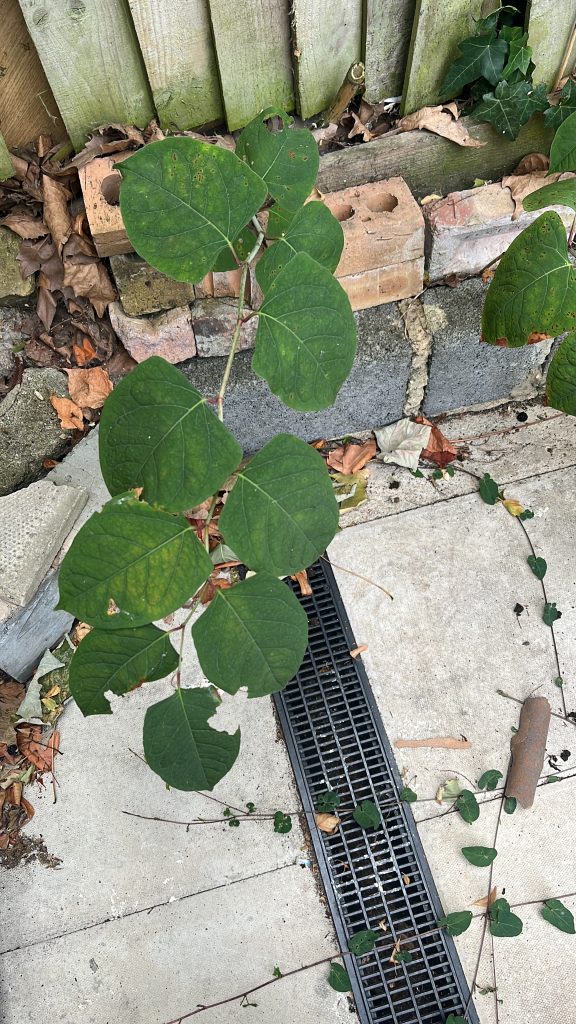Native to Japan, Korea and parts of East Asia and China, the Japanese Knotweed (also known by its Scientific name Fallopia Japonica) is a highly aggressive invasive plant species that can cause damage to the external walls, foundations, grounds and drains. The Japanese Knotweed has the ability to grow up to 20cm per day, 3 metres deep into the ground and spread 7 metres in all directions.
The Environmental Protection Act 1990 designates Japanese Knotweed controlled soil as controlled waste, meaning that only a licensed contractor and licensed disposal facility can be used during its removal and disposal.
It is important to recognise that standard pre-purchase Survey and Valuation reports are not focused on the identification of the invasive plant species. If a Surveyor suspects the presence of Japanese Knotweed, this will be mentioned in the report however specialist investigations will be required to confirm this by using an Arboriculture’s. In this case, it will also be prudent to request for a Japanese Knotweed Management Plan (JKMP), any guarantees and warranties in this regard. We recommend that all specialist investigations and documentation is requested prior to your legal commitment to purchase.
In January 2022, The Royal Institution of Chartered Surveyors has published a Professional Standard document – Japanese knotweed and residential property 1st edition, which can be accessed on: Japanese knotweed and residential property.
The RICS Professional Standards states that “…research has demonstrated, and it is now generally accepted, that Japanese knotweed, poses little or no risk of structural damage to robust buildings with substantial foundations such as dwellings, as opposed to less sturdy structures with shallow foundations, such as conservatories, garages or boundary walls. The so-called ‘7m rule’ focused more on what has been demonstrated to be an overstated risk of Japanese knotweed to buildings, rather than its sometimes-serious impact on amenity…”
Does Japanese Knotweed Affect The Mortgage?
The presence of Japanese Knotweed does not automatically warrant for the refusal of a mortgage offer, provided it is controlled and maintained. Different lenders have a different approach when it comes to assessing mortgage applications. Some lenders will lend as long as there is an eradication plan in place, while others may refuse the application if Japanese Knotweed is found on or within vicinity of the property.
Legal Implications of Japanese Knotweed
It is not a crime to have Japanese Knotweed present on your property, but it has been legally classed as a controlled plant under the Wildlife and Countryside Act 1981 section 14 (2) which states “…Subject to the provisions of this Part, any person who plants, or otherwise causes to grow, any plant in the wild at a place outwith its native range is guilty of an offence…”Therefore, it is against the law to cause a nuisance by allowing the Japanese Knotweed to grow onto another property.
Methods To Control/Eradicate Japanese Knotweed
- Chemical Control: It usually takes at least three to four seasons to eradicate Japanese knotweed using weedkiller. Professional contractors, however, will have access to more powerful weedkiller that may reduce this period.
- Specialist Contractor: Digging-out the deeply penetrating plant, with rhizome which has a potential to spread around 7 meters of its roots, which can be extracted and disposed of by a licensed Contractor.
- Burning: Japanese Knotweed may be burnt when dry however this should be done in controlled environment, with consideration of neighbouring property and fire-spread.
- Using professional companies: Royal Institution of Chartered Surveyors (RICS) has worked with the Property Care Association (PCA) to establish the PCA Invasive Weed Control Group (IWCG) trade body for Japanese knotweed specialists, which provides a register of vetted consultants and contractors. These experts will provide an expert report, outlining the location of the plant, risks involved with suggested treatment plans. This report can be used for mortgage purposes and its commission is insurance-backed.
Further reading and guidance around on the Japanese Knotweed can be found on GOV.UK website – How to stop invasive non-native plants from spreading.
When K & A Chartered Surveyors are instructed to undertake a Building Survey or Homebuyers Report, we will inspect the property and provide you with advice in relation to any Japanese knotweed we may find.
We also see this on many commercial premises when preparing Schedules of Dilapidations for the freeholder and negotiating Dilapidations for the Leaseholders.
If we can be of assistance on any of the above then please do not hesitate to contact us.


